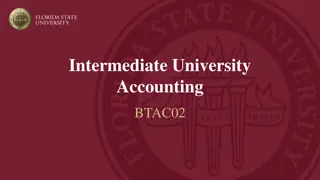Understanding Double Entry Accounting System in Finance
There are two commonly known systems of accounting - single entry system and double entry system. Double entry system is the basis of modern day accounting and ensures accuracy by recording every transaction with dual aspects of debit and credit. By maintaining personal and impersonal accounts, it helps prevent frauds, ensures arithmetical accuracy, and facilitates easy detection and rectification of errors.
Download Presentation

Please find below an Image/Link to download the presentation.
The content on the website is provided AS IS for your information and personal use only. It may not be sold, licensed, or shared on other websites without obtaining consent from the author. Download presentation by click this link. If you encounter any issues during the download, it is possible that the publisher has removed the file from their server.
E N D
Presentation Transcript
Accounting System There are two commonly known systems of accounting namely single and double entry system. Under single entry system; transactions related to personal aspect are recorded, leaving transactions related to impersonal. Since single entry system records only personal aspects, this entry system is considered as incomplete and inaccurate. Whereas, double entry system of accounting is based on the notion that every business transaction is having two equal aspects; one is giving side and other is receiving side. The double entry system is the basis of modern day accounting. It was originated by the luco Pacioli in 1494.Double entry system is further the classified as cash, accrual and mixed accounting system.
Cash system:- In cash system only actual cash receipt and payments are accounted. This system does not record any credit transaction. Generally this system is adopted by the Government Organisation, Financial Institutions and non trading concerns. Accrual system:- It is also known as mercantile system of accounting. In accrual based accounting cash as well a credit transactions are recorded. Apart from cash all income accrued and expenses incurred due during the year are recorded in accrual based system of accounting. Mixed system of accounting:- Under this system combination of cash and mercantile system of accounting is used. In mixed system of accounting, some accounting records are prepared on the basis of cash system whereas others records are prepared under mercantile system.
Double Entry system Double Entry system is the basis of modern day accounting. It is based on the concept of duality which says that every transaction has two aspects i.e. receiver's and giver's side and at any point in time total assets of a business must be equivalent to the total equities. Thus, notion of duality is expressed in the form of accounting equation which forms the basis to record business transactions. In accounting Equation assets connotes resources and equities are claims against these resources.
Features of Double Entry Accounting system A transaction has two-fold aspects i.e. one giving the benefit and the other receiving the benefit. A transaction is divided into two aspects, Debit and Credit. One account needs to be debited and the other is to be credited. Every debit must have its corresponding and equal credit.
Advantages of Double Entry Accounting system As both the personal and impersonal accounts are maintained under the double entry system, both the effects of the transactions are recorded. It assures arithmetical accuracy of the books of accounts, for every debit, there is a corresponding and equal credit. This is arrived by preparing a trial balance periodically or at the end of the financial year. Prevents and minimizes frauds. Frauds can be even detected early. Errors can be checked and rectified easily. The outstanding balances of receivables and payables are determined easily since the personal accounts are maintained. Businesses can compare the financial position of the current year with that of the past year/s.
Helps to justify the standing of business on the valuation date in comparison with the previous years' purchase, sales, and stocks, incomes, and expenses with that of the current year figures. The calculated net operating results can be ascertained by preparing the trading and profit and loss A/c for the year ended and the financial position can be ascertained by the preparation of the balance sheet. Government can easily decide on the tax to be calculated on the business's net earnings. Outsiders and stakeholders like suppliers, banks, holders of equity, etc. take a proper decision regarding grants of credit or loans or subscribing for the shares.























